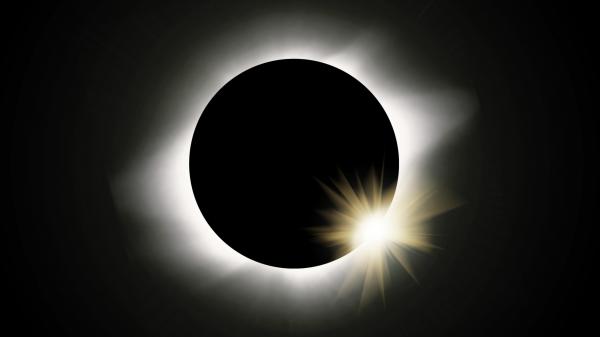10 Facts About the March 20, 2015 Total Solar Eclipse
The March 20, 2015 Total Solar Eclipse will be a grand and rare total eclipse of the Sun. Here are 10 facts not to be missed.

The max point of a Total Solar Eclipse
©bigstockphoto.com/ IgorKovalchuk
Animation: Next Eclipse in Your City
1. It's the First Eclipse of 2015
2015 has 4 eclipses, the minimum number of eclipses that take place in a calendar year. There will be two solar eclipses – the March 20 Total Solar Eclipse and a Partial Solar Eclipse on September 13, 2015 – and two Lunar Eclipses, on April 4 and September 28.
How often do Solar Eclipses happen?
2. Vernal Equinox on the same day
Having a total solar eclipse itself makes a date notable, but March 20 is extra special because it is also the March Equinox!
A total solar eclipse coinciding with Northern Hemisphere's Spring Equinox and Southern Hemipshere's Autumn or Fall Equinox hasn't happened since 1662 and will not happen again until March 20, 2034.
10 things you should know about the March Equinox
3. Super New Moon Blocks the Sun
Total eclipses of the Sun happen when a new Moon comes between the Sun and the Earth and covers the entire disc of the Sun. In March 20, only 12 hours before the beginning of the eclipse, the Moon will be at its perigee – the point closest to the Earth on its orbit around it. This makes the Moon on March 20, 2015 a Super New Moon.
4. Totality Visible only in a Few Towns
Unfortunately most of the grandness of this Total Solar Eclipse will go unnoticed because the path of totality, while fairly wide – around 300 miles (483 kms) – falls right over the Northern Atlantic Ocean between the coasts of Greenland and Norway. Only two populated and easy-to-access locations – Svalbard, an island belonging to Norway and the Faroe Islands – will the Sun be totally eclipsed.
Interest in the Eclipse has been so high both among the scientific and the lay community that hotels in Svalbard were all booked out for the eclipse weekend way back in 2008!
Stages of a Total Solar Eclipse
5. Europe sees Partial Eclipse
If you do not live in or visit Svalbard or the Faroe Islands, do not despair. Most of Europe, northern and eastern Asia as well as northern and western Africa will be treated to a partial eclipse.
Those in Europe are especially well located to view a spectacular Partial Solar Eclipse, with parts of Northern Europe, United Kingdom and Ireland being able to see almost 96% of the eclipse, weather permitting of course.
The March 20, 2015 eclipse is the last Total Solar Eclipse visible from anywhere in Europe until August 12, 2026.
6. Worries of Power Shortage
Some European countries are concerned that the Solar Eclipse may affect their power supplies, given that about 10.5 % of all electricity generated in the contient comes from solar power.
Power companies in Europe are expecting an electricty shortage of about 35,000 mega watts during the course of the eclipse.
7. Short Spectacular Totality
For those who are fortunate enough to be able to view the eclipse from Svalbard and the Faroe Islands, totality may be short – it will last for 2 minutes 40 seconds – but it will be full of spectacular sights. These include Baily's beads, the diamond ring, the Sun's chromosphere and corona and shadow bands.
Sights only seen during a Total Solar Eclipse
8. You'll Need Protective Equipment to See the Eclipse
Never look directly at the sun! It's dangerous and can harm your eyes and even cause blindness. The safest way to see a solar eclipse is to wear protective eclipse glasses or use a pinhole projector you can easily make yourself.
9. Part of Saros Series 120
Solar eclipses tend to occur in cycles. The Saros Cycle, one of the most studied eclipse cycles, occurs every 18 years. Two solar eclipses separated by a Saros Cycle have similar features – they occur at the same lunar node, with the Moon roughly at the same distance from the Earth. The eclipses also take place at about the same time of the year and around the same time of day. Eclipses that are separated by a Saros Cycle are included in a Saros Series.
The March 20, 2015 Total Solar Eclipse belongs to Saros Series 120. The series began with a Partial Solar Eclipse visible from the Southern Hemisphere on May 27, 933 CE and will end with a Partial Solar Eclipse visible in the Northern Hemisphere on July 7, 2195.
The next eclipse in the series – a Total Solar Eclipse – will take place on March 30, 2033.
10. Two Weeks Later, There's a Lunar Eclipse
Another oddity of nature is that solar eclipses and lunar eclipses tend to come in pairs – a solar eclipse always takes place about two weeks before or after a lunar eclipse. Two weeks after March 20, 2015, on April 4, 2015, a lunar eclipse will take place. This eclipse is the third in a series of 4 lunar eclipses that form the Blood Moon tetrad. It will be visible from parts of North America, South America, Asia and Australia.